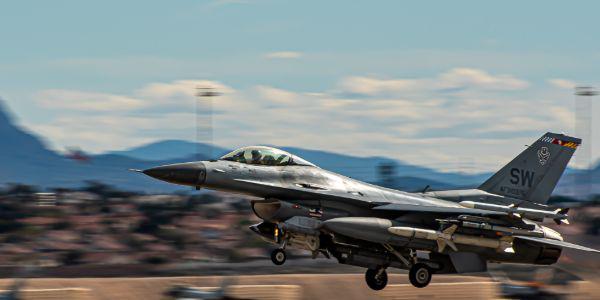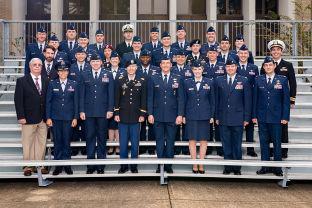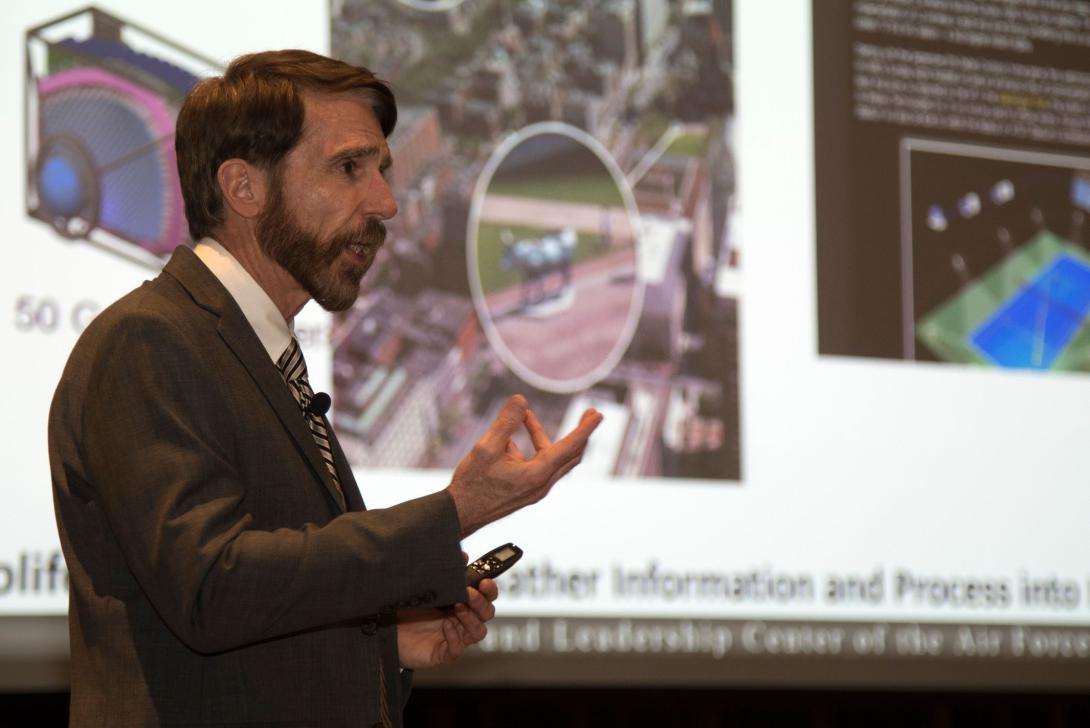Preparing Leaders for Joint Multidomain Warfighting
To prepare, operate and fight in joint warfare against near-peer adversaries across all domains will take adroit leaders who provide effective decisions in near or real time. The Air Command and Staff College, or ACSC, has set a course to do just that: prepare leaders to thrive and fight with joint operations in a contested environment on a global scale using joint all-domain command and control, or JADC2. Leaders in the class learn to plan and execute multidomain operations against possible threats on land, sea, air, space and cyberspace to lead through the challenges of the expected future operational environment in 2030 and beyond.
Part of the U.S. Air Force’s Air University, ACSC, located at Maxwell Air Force Base in Montgomery, Alabama, offers the year-long, graduate-level Joint All-Domain Strategist course. And even though it is presented at ACSC, JADS, as it is known, is available to leaders from all of the services—Army, Navy, Marine Corps and Space Force—explains the ACSC’s Jeffrey Reilly, director of joint education.
Previously called the Multi-Domain Operational Strategist class, JADS was redesignated last fall to capture the joint nature of the course, Reilly says. It is available to any military leader or interagency official enrolled in residential curriculum at ACSC, but it has to be their choice to take this specialized class, as it is advanced and rigorous, the director notes.
“It is a pretty demanding course,” he states. “Our faculty is in with them over 200 days a year. We get to know them and try to structure their research and what they are learning in a very specific way so that each individual gets something.”
The ever-relevant course needed for today’s emerging environment actually started by accident, explains Reilly, a former Army infantry officer with 26 years of active-duty experience, which began with the Vietnam War. He was teaching at the University of Alabama prior to joining ACSC in 2006.
“I was asked to come up with a research problem, and head of the ACSC’s research department came by and said, ‘Your students are waiting for you.’ I said, ‘What students?’ And he said, ‘Your research students.’ So, I had six students, and I scrambled it all together, and we ended up staying together for an entire year. That class produced two general officers. And then we went from a once-a-week elective to offering three classes. And in 2017, we offered a full load of courses. We teach at a very high level. It’s been a great opportunity for us to influence some very good leaders. And we are pretty proud of our graduates.”
For already accomplished leaders, the structure of the four-semester JADS course aims to further improve their operational-level critical thinking and problem-solving skills. The concentration in JADS specializes in developing leaders who understand the challenges within each domain and jointly in all domains, as well as to confront any human limitations. In addition, the students examine and apply strategic and operational design, reflexive control theory, aggregation theory, decision-making theory and risk analysis, Reilly clarifies.
The 48 students in the course come from all specialties in the military. “We’ve had fighter pilots, logisticians, cyber experts, space experts, soldiers, navy submarine officers, Marines, infantry officers, test pilots and intelligence officers,” the director says. “And the 48 students are broken into seminars of 12 students, and each one of the seminars has a good cross-section of specialties.”
Difficult problems that are presented are intentionally ill-defined to challenge the leaders as they research, plan, problem-solve and execute ideas in command and control; computing; communications; intelligence, surveillance and reconnaissance; and operational decision-making.
“Their first class at the very beginning of the year is, ‘This is 2035,’” the professor says. “We go through the climate, we go over the demographics throughout the world, the geopolitical environment and disruptive technology. We show them the challenge that they are going to have. And then we close back with that at the end of the year.”
ACSC began teaching all-domain theory and operations in 2006, Reilly continues. “And we started teaching global integrated operations in 2013, which is now at the forefront of what we are looking at right now in terms of doctrine,” he states. “That is what we want to do. We want to stay at least five years ahead of everyone else so that we produce leaders that can adjust to the environment.”
Each one of the JADS subcourses is oriented on a specific theater of operations. The students are split up into red-blue teams against each other and given “very, very tough problems,” Reilly says. “Students switch sides so that they get a balance, and they are taught to think in 360 degrees. And every student has to lead. We have a very sharp focus on leadership. The leadership courses give our students the theory, and then they have to lead their peers through these problems. And there are major levels that they have to actually go through. They will have four major positions in red and blue scenarios, and then they will have to lead their peers through those.”
The course culminates in a two-month domain integration exercise based on a future 2030 scenario. The students have a final problem set to solve, spend three weeks planning and then move to crisis action and operational execution phases. “They will develop a plan, and while they are developing the plan, we are changing the environment,” the director says. “And they have to anticipate changes. They have to adapt to those changes and respond. As we go through into crises action and the tempo picks up, we go into execution and then at the end, we will evaluate not only how the students did but also how we as a faculty did.”
In addition to frequent wargaming, the students also deploy to military exercises and events for experiential learning. This year, amidst the pandemic, JADS students attended the Pacific Fury exercise in February. Other students and faculty members attended the Combat Air Forces Weapons and Tactics Conference in January at Nellis Air Force Base. Another group went to the Advanced Battle Management System (ABMS) On-Ramp 4 testing at Nellis in March, which provided “tremendous insights into the challenges and complexity of developing the ABMS. The opportunity to observe the execution of ABMS On-Ramp 4 in Europe [from Nellis] provided invaluable experiential learning in concept development and requirements for test and evaluation,” Reilly observes. In the past, JADS students have attended the Pacific Century exercise, in Honolulu, and the Key Resolve exercise, at Osan Air Force Base, Korea. JADS students also usually conduct annual interagency visits with the CIA, National Security Agency, the White House, Department of State and other organizations.
Given that the United States will not conduct joint all-domain warfare on its own, JADS also has a heavy international partner component—for the JADS students to learn from the partners, Reilly emphasizes. “If COVID was not an issue, we would have traveled internationally to the Führungs Academy in Hamburg, Germany, to the War Studies University in Warsaw, Poland, or to the Royal Danish Defense college,” he states. In February, the director also established new ties with the Indian Army and their Center for Land Warfare Studies. “In the first webinar meeting, they had their minister of defense, their chief of staff of the Indian Army, as well as media and academia,” Reilly shares.
Indeed, their prestige is growing throughout the world, the professor continues. “The irony is that we have no international students in our courses because we teach at the top-secret level, but we have this growing international reputation for what we do,” he says.
Besides preparing the leaders, another objective of JADS is to help inform operational planning for the U.S. combatant commands, with students providing research to assist with the various commands’ real-world operational needs in JADO, Reilly states. Previous JADS students have prepared operationally related products for Joint Special Operations Command, the Special Operations Command, Strategic Command, Special Operations Command Pacific, Project Checkmate, and the National Security Council. For example, projects from last year’s students examined the application of Agile Combat Employment in contested and degraded environments.
Moreover, the director sees JADS functioning as a research laboratory for emerging doctrinal concepts regarding JADO and JADC2. In November at Maxwell, Air University hosted a symposium on the topics, bringing military and government officials together to consider the processes for planning, decision and execution of joint all-domain warfare in contested and degraded communications environments.
Additionally, the course is a prerequisite for the leaders volunteering for the new, so-called 13O career field of Multi-Domain Warfare Officers, Reilly offers.
The students must also produce the Over the Horizon digital journal—which is on the chief of staff of the Air Force’s reading list and also is gaining global notice. “We teach them executive writing for general officers as well as writing for research and publications,” Reilly states. “The students not only run the website, but we make them publish. And the articles written by JADS students have received as many as 20,000 reads from 140 countries.”
For advancing the joint and multidomain warfighting abilities of service members, JADS won the Air Education and Training Command’s Innovation Award in 2018, and in 2019 received two Secretary of the Air Force awards for leadership. The former secretary, Barbara Barrett, in testimony to the Senate Armed Services Committee, called JADS an example of how Air Force professional military education should be conducted, Reilly shares.
“We are not a perfect course,” the director says. “I do try and correct that every year and make the course better for the next year,” the director adds. “We are under-resourced, both financially and faculty-wise. But as we’ve grown and with our stakeholders at the four-star level, which includes the Chief of Staff of the Air Force Gen. [Charles] Brown and Gen. [Jeffrey] Harrigian [commander, U.S. Air Forces in Europe and Africa], we’ve grown a very good reputation and they are very supportive of us. As a result of that, we are starting to get the resources to really make a difference. Our objective is in one-man year to produce what the Air Force calls an advanced study graduate, or what the Army calls a military studies program graduate. And we are getting pretty close to that.”






Comments